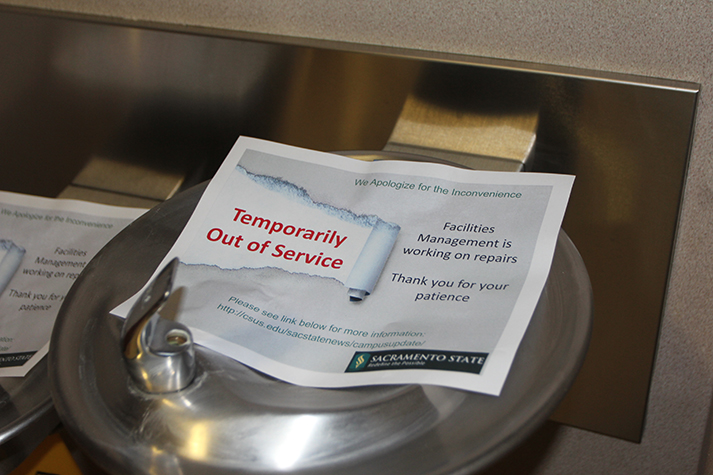EDITORIAL: University can’t just do bare minimum for students
Kameron Schmid – The State Hornet
Water fountains in Placer Hall, as well as six other Sacramento State buildings, are currently shut off after a research project over winter break found excess levels of lead.
May 2, 2018
Over and over (and over and over), different branches of Sacramento State’s leadership have done the bare minimum to serve the students who justify the University’s existence.
Sometimes, they don’t even do the bare minimum.
A state audit of the health and safety practices at Sac State found that the University — as well as other CSUs — has not provided acceptable safety measures for students and employees working with unsafe chemicals.
The audit found that the four campuses that were reviewed “did not consistently comply with requirements related to the oversight of health and safety policies, training, and the inspection of laboratory safety equipment.”
The results of this audit have been anticipated since last June, when it was requested by four state legislators citing a “disturbing trend” of dangers to the health and safety of students and employees.
RELATED: Students inconvenienced by campus infrastructure failures
These disturbing trends, as applicable to Sac State, include a chemical spill in 2016 and the questionable method of chemical storage on campus, which multiple Sac State employees now claim left them with health problems, including compromised fertility.
These claims are now the subject of an ongoing lawsuit against the University.
In the time between the health and safety audit’s beginning and the final report, the Sacramento County Environmental Management Department discovered three major health code violations among a total of 14 violations on Feb. 16 while performing an official health inspection of The Servery at the Dining Commons at Sac State.
The three major violations were related to food being in the “temperature danger zone,” not recording how long certain foods had been out and improper sanitation.
Another data point in this trend is the fact that the school did not publicize the presence of lead above state and federal standards in school drinking water for 10 months.
State Hornet reporting last spring showed the gap, as well as highlighting a public disagreement on the treatment of the lead issue between Sac State and the University’s foremost expert on toxicology, environmental department chair and Ph.D.-holding professor Jeffery Foran.
Outside of the realm of health and safety, the Sac State women’s and men’s tennis programs are now under three years of probation through April 18, 2021 after an NCAA report cited numerous infractions involving the University, former players, coaches and the director of tennis.
We’ve written much in the past about how the CSU is ill-equipped to handle the changing landscapes of higher education with a budget that is always putting more strain on student tuition as state dollars evaporate in proportion to how many students enroll.
But if administrators want to increase four-year graduation rates, asking students already struggling to pay for school, rent, food and life to take 15 units a semester no matter what and succeed no matter what, students should in turn be able to ask loudly and aggressively why Sac State and the CSUs can’t quit struggling to do the things they’re required to do, let alone improve on them.
Students and employees need to know they are supported by adequate facilities and resources during their education or profession, especially in hands-on fields like chemistry.
Your university asks a lot of you. Don’t be afraid to ask a lot — or at least the bare minimum — of it in return.

































































































































Anon • May 8, 2018 at 2:36 pm
What astonished me was the fact that some one my friend’s living at the dorms didn’t have soap in the dispensaries or water filters changed in a timely matter.
They expect us to go in debt for this education but won’t even focus on the things that will help us get there. Finish in four, seriously? The only cents Sac State wasted away was at those billboards, because writing pamphlets about how you should see your counselors every semester isn’t something unknown. We need real programs, real unity, and real effort to help our student body become successful.
The board of trustees and most CSU President’s weren’t in a position of poverty when they attended college, so why should we expect them to understand our struggles? It is up to us and the city of Sacramento to push forward.
Sac State cares more about their sports programs then their 3000 homeless students